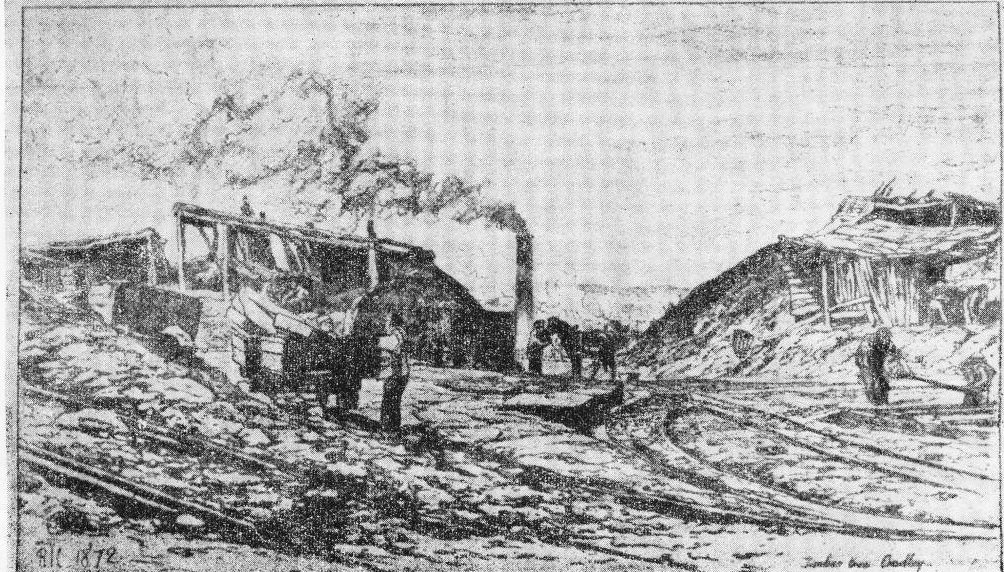Covering an area of several acres between Brierley
Hill and Old Hill, and bounded on the west by Netherton, and the
east by Cradley Heath, was Saltwells Colliery.
- The brooch coal
- The twofeet coal
- The thick coal
- The heathen coal
Beneath the Heathen coal was the white ironstone, a seam about
4 feet thick containing several layers of ironstone. There was
a ready market for ironstone, it was used as a flux in smelting
other ironstone or iron ores.
In total 33 mines made up the colliery, each with their own
winding plant and means of ventilation. The winding plants were
horizontal steam engines of 18hp geared to the drum of about
8 feet in diameter. At the number 27 pit (at Darby End in Netherton)
the winding plant was known as "Iron Jack" - a vertical
steam cylinder connected to a beam at one end and the other
end of the beam connected to the winding drum.
The number 20 pit had the central pumping station with a large
steam vertical cylinder having a very heavy flywheel lubricated
by a water jet.
 |
|
Timber
Tree Colliery Cradley (from etching by RS Chattock 1872
|
The actual mining of the coal and ironstone was undertaken
by "Charter masters", specially qualified men with
training and experience, often being the sons of charter masters.
These were contracted with the Earl's mining agents to supply
the labour, horses, tools, candles, explosives and light beer
to be sent down in small kegs at midday. They were not responsible
for the winding plants and the sinking of shafts. They were
paid tonnage rates, the rates were obtained by weighing machines
on the private railway and by the guaging of canal boats.
The miners were paid on Saturday, the Saturday working day
being the same as other days meant that the wives could not
do their shopping until late in the day, sometimes as late as
midnight. This was later changed to Friday. If the free pit
beer was not up to standard the men would complain and frequently
refuse to work. To remove this problem it was agreed with the
miners' agents to pay an increase on wage rates.
The Government Mining Inspectors recommended that the Charter
Masters be relieved of supplying the timber used for support
of roadways and working places in order to remove any tendency
to economise and thereby increase the likelihood of falls. This
was implemented by the Charter Masters purchasing supplies and
the accounts were passed to the Earl's agents for payment, charter
rates being adjusted to cover the change in conditions. This
change had no effect on accident rates.
The last pair of shafts to be sunk was the number 33 pit situated
at Quarry Bank. The coal measures were lying at an angle of
45 degrees to the horizontal so that a great thickness was found
in the shafts. This was further complicated by the fact that
if a roadway had to be driven in the same section of the seam,
it was continually altering direction and describing a curved
formation on the plan.
A large area of the coal to be worked lay under what was known
as the Cradley Pool, which was used for pleasure with rowing
boats. The effect of subsidence of the surface is naturally
greater with a thick seam than a thin one, so that the pool
was drained off into the Mouse Sweet brook (at the eastern edge
of the colliery) and into the River Stour to prevent any liability
of flooding at the workings. Another large area lay under the
surface closely covered by buildings, houses, shops and small
factories. The Earl had the legal right to mine coal without
being liable to damages. In fact he created a fund for paying
compensation to people suffering loss. With their shares of
the compensation two owners of factories purchased land elsewhere
where they would be free of subsidence and had room for extensions.
Surveying of workings under these conditions presented difficulties
and in order to reduce the interference by men and horses at
work, when Mr Poole became surveyor of the mine, arrangements
were made that the surveying was done after the day shifts work.
The surface winding plant was modern in design, a pair of horizontal
steam engines directly coupled to the drums. These engines could
accelerate the motion of the cage faster than the pithead pulley
would respond, the slipping of the winding rope on the pulley
accounted for excessive wear of both rope and pulley. It is
said that a race had been run between a stone being dropped
with the coomencement of the descent of the cage. Mr Poole never
asked to be let down slowly but always took the precaution of
filling his lungs to full capacity at the start.
Number 33 pit was the only pit to have a steam-driven ventilating
fan. The ventilating current at the other pits was produced
by a fire in a recess in the side of the shaft near the bottom
of the pit. It was the duty of the cager or onsetter to attend
to this fire. Another method was to install a steam pipe from
the boilers down the shaft and near the bottom of the pit connected
with a circular pipe perforated with holes to direct the steam
in upward jets.
A duty of Mr Poole as an apprentice was to pay a monthly visit
to each mine to test the flow of air passing through with an
anemometer. A register of the results of these visits was kept
in the mining office and the manager could order an investigation
if there appeared to be less than the average quantity flowing.
To get a correct quantity of air, it was necessary to have someone
to time a minute's run and the anemometer to be slowly moved
from side to side and from roof to floor.

